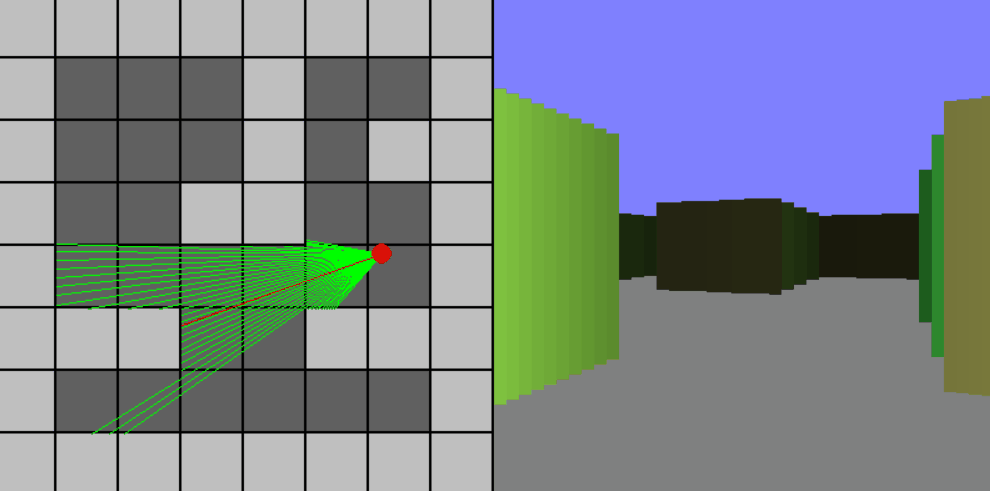So I have made a raycaster in Python using pygame. I cast my rays little bit by bit and once they've hit a wall, I calculate the distance and use that base the height of my walls. The problem is that my walls are curved.
I had thought I had fixed this problem by adding this
angle = math.radians(self.view - degree)
dist *= math.cos(angle)
But with that the walls to the left or right of me would still be curved.
Here is the full code or you can play it here!
#Import modules
import pygame
import math
#Set up window
pygame.init()
winWidth, winHeight = (1024, 512)
window = pygame.display.set_mode((winWidth, winHeight))
#Make player object
class Player:
def __init__(self, x, y, tm, fov, view):
self.x = x
self.y = y
self.tm = tm #tilemap
self.fov = fov #field of view
self.view = view #players angle
self.movements = {'w': False, 'a':False, 's':False, 'd':False}
self.distances = []
self.img = pygame.image.load("tile_test.png").convert_alpha()
self.img = pygame.transform.scale(self.img, (64, 64))
def update(self): #Player movements
radAngle = math.radians(self.view)
if self.movements['w'] == True and self.tm[int(self.y+(math.sin(radAngle)*0.05))][int(self.x+(math.cos(radAngle)*0.05))] == 0:
self.x += math.cos(radAngle)*0.05
self.y += math.sin(radAngle)*0.05
if self.movements['a'] == True:
self.view -= 3
if self.movements['d'] == True:
self.view += 3
def draw(self, window):
#---TopDown View---
#Map
for y, row in enumerate(self.tm):
for x, tile in enumerate(row):
if tile == 1:
pygame.draw.rect(window, (255,255,255), (x*64, y*64, 64, 64))
pygame.draw.rect(window, (0,0,0), (x*64, y*64, 64, 64), 1)
else:
pygame.draw.rect(window, (0,0,0), (x*64, y*64, 64, 64))
pygame.draw.rect(window, (255,255,255), (x*64, y*64, 64, 64), 1)
#player
pygame.draw.circle(window, (255,255,0), (self.x*64, self.y*64), 8)
#Rays :D
self.distances = []
for degree in range(int(self.view-(self.fov/2)), int(self.view+(self.fov/2))):
radAngle = math.radians(degree)
rayx = self.x
rayy = self.y
stop = False
while self.tm[int(rayy)][int(rayx)] == 0 and stop == False:
rayx += math.cos(radAngle)*0.01
rayy += math.sin(radAngle)*0.01
#Calculate ray distance
dist = math.sqrt(((rayx-self.x)*(rayx-self.x)+(rayy-self.y)*(rayy-self.y)))
#Draw the ray
pygame.draw.line(window, (0,255,0), (self.x*64, self.y*64), (rayx*64, rayy*64))
#Decide if colides horizontally or vertically (To help with drawing tiles)
rx = round(rayx - int(rayx), 5)
ry = round(rayy - int(rayy), 5)
h_col = False
if rx > .5:
if ry > .5 - (rx - .5) and ry < .5 + (rx - .5):
h_col = True
else:
h_col = False
elif rx <= .5:
if ry > .5 - (.5 - rx) and ry < .5 + (.5 - rx):
h_col = True
else:
h_col = False
if h_col == True:
num = ry
else:
num = rx
#Attempt at fixing curved walls. Works somewhat but not really
angle = math.radians(self.view - degree)
dist *= math.cos(angle)
self.distances.append((dist, num))
#draw player view ray
pygame.draw.line(window, (255,0,0), (self.x*64, self.y*64), ((self.x+math.cos(math.radians(self.view)))*64, (self.y+math.sin(math.radians(self.view)))*64))
#---3D View---
for x, line in enumerate(self.distances):
height = 256 - round(line[0], 1)*42
if height <= .5:
height = .5
w, h = self.img.get_width(), self.img.get_height()
img_x = int(line[1]*w)
if img_x > 63:
img_x = 63
elif img_x < 0:
img_x = 0
img = self.img.subsurface(img_x, 0, 1, h)
img = pygame.transform.scale(img, (8, height*2))
window.blit(img, (512+(x*8), 256-height))
class Control:
def __init__(self):
self.run = True
self.clock = pygame.time.Clock()
def update(self):
for event in pygame.event.get():
if event.type == pygame.QUIT:
self.run = False
if event.type == pygame.KEYDOWN:
if event.key == pygame.K_w:
player.movements["w"] = True
if event.key == pygame.K_a:
player.movements["a"] = True
if event.key == pygame.K_s:
player.movements["s"] = True
if event.key == pygame.K_d:
player.movements["d"] = True
if event.key == pygame.K_ESCAPE:
self.run = False
elif event.type == pygame.KEYUP:
if event.key == pygame.K_w:
player.movements["w"] = False
if event.key == pygame.K_a:
player.movements["a"] = False
if event.key == pygame.K_s:
player.movements["s"] = False
if event.key == pygame.K_d:
player.movements["d"] = False
game = Control()
tm = [
[1,1,1,1,1,1,1,1],
[1,0,1,0,0,0,0,1],
[1,0,1,1,0,1,0,1],
[1,0,0,0,0,1,0,1],
[1,1,1,1,0,1,0,1],
[1,0,1,1,0,0,0,1],
[1,0,0,0,0,0,0,1],
[1,1,1,1,1,1,1,1]
]
player = Player(3.5, 3.5, tm, 64, 0)
while game.run:
window.fill((50,50,50))
player.draw(window)
pygame.display.update()
game.update()
player.update()
game.clock.tick(30)
pygame.quit()


